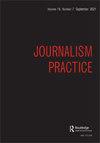Mission vs. Money: Professional Values and Attitudes of Public and Commercial Media Journalists in the United States
IF 2
2区 文学
Q2 COMMUNICATION
引用次数: 0
Abstract
ABSTRACTThis study compares the demographics, professional values, and attitudes of public and commercial journalists in the United States. Based on survey interviews with representative samples of 394 public broadcasting journalists and 1,491 commercial journalists, the study finds significant differences in demographics, attitudes, and role perceptions between the two groups. Public media journalists, who tend to be younger, more politically left-leaning, more racially diverse, and work in more gender-balanced newsrooms than their commercial colleagues, appear more mission-driven and prefer to tell complex, interpretive stories to help the public take action. By contrast, commercial journalists prize publishing quickly to the broadest possible audience while showing less interest in influencing public affairs.KEYWORDS: Public broadcastingjournalismNPRPBScomparativesurvey Disclosure StatementNo potential conflict of interest was reported by the author(s).Notes1 We define the terms “liberal” and “conservative” in relation to these two American political parties to separate our definition from broader conceptions that are often grounded in political ideologies. Feldman (Citation2013), for example, defines left-wing ideologies such as socialism to be “based on the values of equality, social justice, and widespread involvement in the political system” (p. 594) and right-wing ideologies—including nationalism and fascism—as those that “emphasize social control and unequal influence over political and economic systems” (p. 594). Since the United States is neither a socialist nor a fascist nation, we align political beliefs with the two dominant U.S. parties. In so doing, we follow a rich tradition of literature about the U.S. media, which equates “liberal” and “conservative” attitudes with being “Democratic” and “Republican,” respectively (e.g., Garrett and Bond Citation2021; Hmielowski et al. Citation2020; Lee and Hosam Citation2020). While we asked journalists to identify their preferred party affiliations, we also allowed them to place themselves on an ideological scale ranging from “very liberal” to “very conservative.” We offer these multiple opportunities at definition in part because, as Barber and Pope (Citation2019) note, researchers have consistently found that Americans identify themselves using an entanglement of both party and political affiliation.2 Because both commercial and public media journalists received the same questionnaire (except for a series of some questions on the performance of U.S. public broadcasting), this move of respondents from the main to the public sample does not affect the statistical analyses nor does it significantly impact the representativeness of each sample.Additional informationFundingThis work was supported by Syracuse University and the John Ben Snow Foundation.使命与金钱:美国公共和商业媒体记者的职业价值观和态度
摘要本研究比较了美国公共新闻记者和商业新闻记者的人口结构、职业价值观和态度。基于对394名公共广播记者和1491名商业记者的代表性样本的调查访谈,该研究发现,这两个群体在人口统计学、态度和角色认知方面存在显著差异。与商业记者相比,公共媒体记者往往更年轻,政治上更左倾,种族更多元化,在性别更平衡的新闻编辑室工作,他们似乎更有使命感,更喜欢讲述复杂的、解释性的故事,以帮助公众采取行动。相比之下,商业记者看重的是迅速向尽可能广泛的受众发表文章,而对影响公共事务的兴趣则较少。关键词:公共广播新闻比较调查披露声明作者未报告潜在的利益冲突。注1:我们将“自由主义”和“保守主义”这两个术语与这两个美国政党联系起来,以便将我们的定义与通常基于政治意识形态的更广泛的概念区分开来。例如,费尔德曼(Citation2013)将社会主义等左翼意识形态定义为“基于平等、社会正义和广泛参与政治体系的价值观”(第594页),而右翼意识形态——包括民族主义和法西斯主义——则是“强调社会控制和对政治和经济体系的不平等影响”(第594页)。由于美国既不是社会主义国家,也不是法西斯主义国家,我们的政治信仰与美国两大主要政党保持一致。在这样做的过程中,我们遵循了关于美国媒体的丰富文学传统,将“自由”和“保守”的态度分别等同于“民主党”和“共和党”(例如,Garrett和Bond Citation2021;Hmielowski等人。Citation2020;Lee and Hosam Citation2020)。当我们要求记者确定他们喜欢的党派关系时,我们也允许他们将自己置于从“非常自由”到“非常保守”的意识形态范围内。我们在定义时提供了这些多重机会,部分原因是,正如Barber和Pope (Citation2019)所指出的那样,研究人员一直发现,美国人通过政党和政治派别的纠缠来识别自己由于商业媒体和公共媒体记者收到的问卷是相同的(除了一系列关于美国公共广播表现的问题),因此受访者从主要样本转向公共样本并不影响统计分析,也不会显著影响每个样本的代表性。本研究得到了雪城大学和约翰·本·斯诺基金会的支持。
本文章由计算机程序翻译,如有差异,请以英文原文为准。
求助全文
约1分钟内获得全文
求助全文
来源期刊

Journalism Practice
COMMUNICATION-
CiteScore
5.50
自引率
14.30%
发文量
111
期刊介绍:
ournalism Practice provides opportunities for reflective, critical and research-based studies focused on the professional practice of journalism. The emphasis on journalism practice does not imply any false or intellectually disabling disconnect between theory and practice, but simply an assertion that Journalism Practice’s primary concern is to analyse and explore issues of practice and professional relevance. Journalism Practice is an intellectually rigorous journal with all contributions being refereed anonymously by acknowledged international experts in the field. An intellectually lively, but professionally experienced, Editorial Board with a wide-ranging experience of journalism practice advises and supports the Editor. Journalism Practice is devoted to: the study and analysis of significant issues arising from journalism as a field of professional practice; relevant developments in journalism training and education, as well as the construction of a reflective curriculum for journalism; analysis of journalism practice across the distinctive but converging media platforms of magazines, newspapers, online, radio and television; and the provision of a public space for practice-led, scholarly contributions from journalists as well as academics. Journalism Practice’s ambitious scope includes: the history of journalism practice; the professional practice of journalism; journalism training and education; journalism practice and new technology; journalism practice and ethics; and journalism practice and policy.
 求助内容:
求助内容: 应助结果提醒方式:
应助结果提醒方式:


